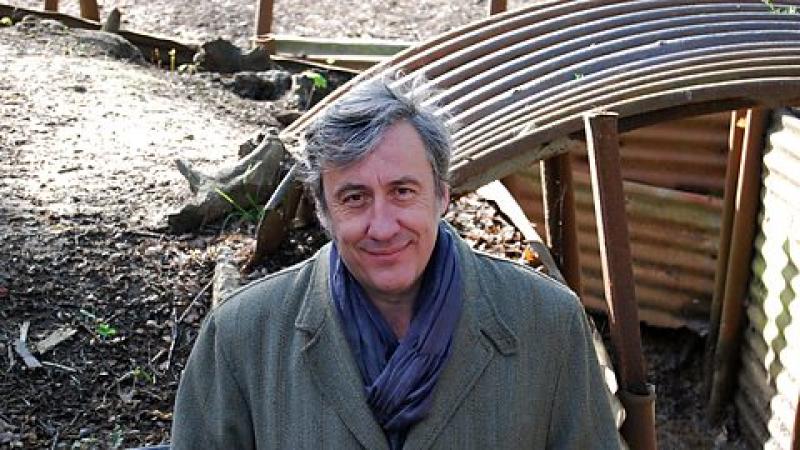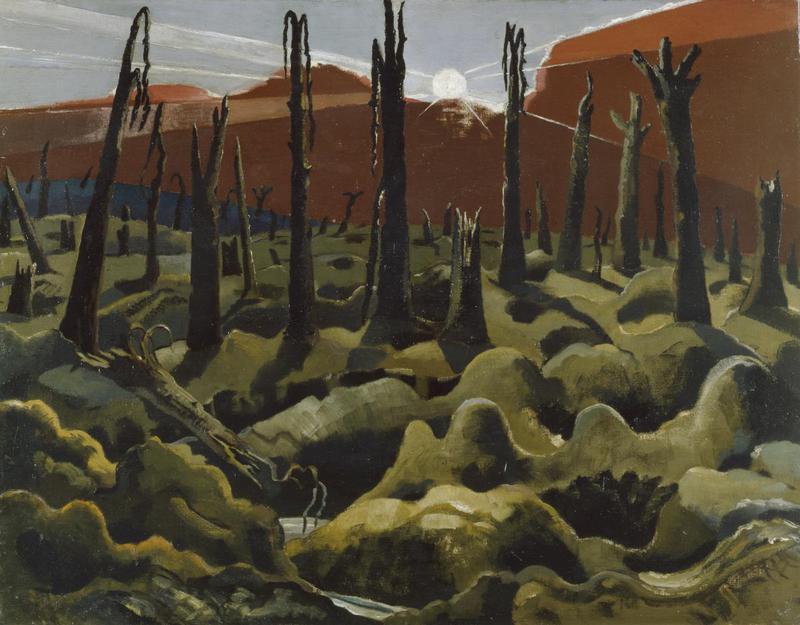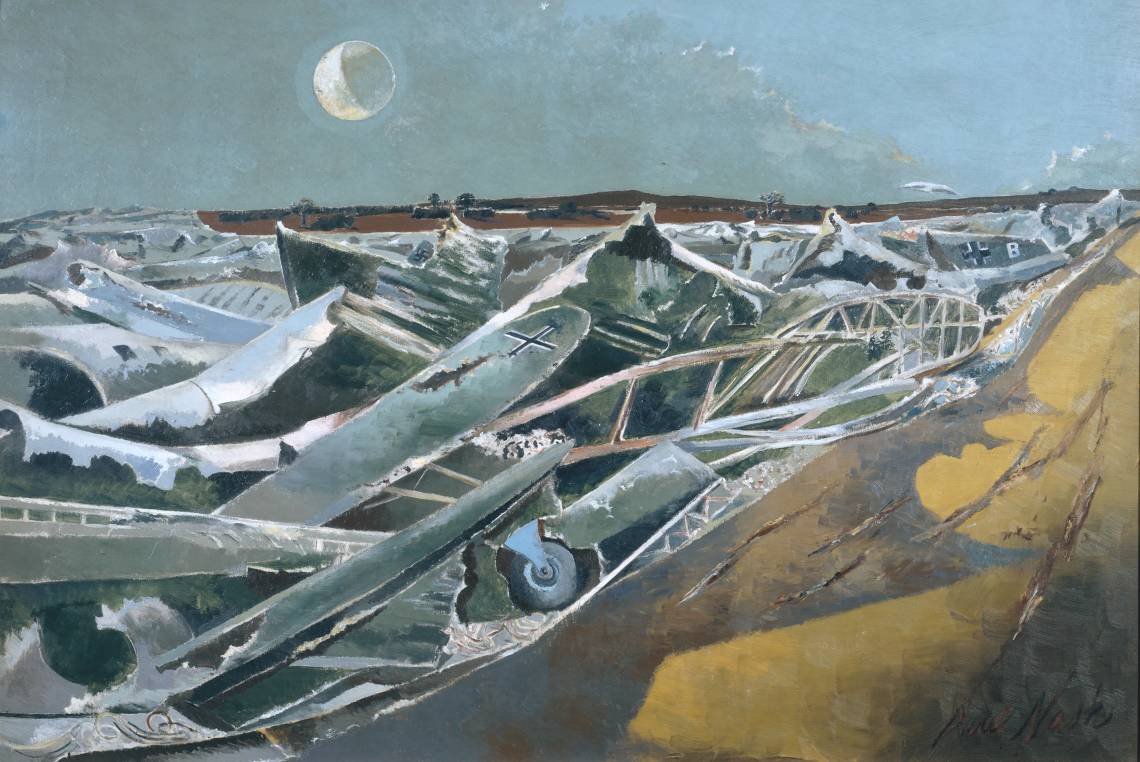British Art at War: Bomberg, Sickert and Nash, BBC Four | reviews, news & interviews
British Art at War: Bomberg, Sickert and Nash, BBC Four
British Art at War: Bomberg, Sickert and Nash, BBC Four
Andrew Graham-Dixon begins an excellent trilogy about World War One artists with Paul Nash

At the end of this absorbing documentary about the art – and life – of Paul Nash we visited his tombstone in a Buckinghamshire churchyard, accompanying writer and presenter Andrew Graham-Dixon as he laid sunflowers on the grave. He reminded us that Nash saw the sunflower as a symbol for the soul, turning to the sun; indeed one of his last paintings was “Solstice of the Sunflower”.
The final phrase Graham-Dixon used about this highly literate and intelligent artist was that he had been haunted by life, haunted by death, and by the ghosts of war. Unusually, Nash was an official war artist in both World War One and Two. This programme, Paul Nash: The Ghosts of War, was the first in a trilogy, with the two programmes to come devoted to David Bomberg and Walter Sickert.
Nash’s melancholy shadowed both the film and the presenter, who strode round the English country- and sea-side, not to mention Belgium and France, costumed in drab trenchcoats and scarves in a subliminal echo of military colours. As Graham-Dixon clambered in and out of the reconstructed trenches of First World War battlefields, through Belgian forests and English meadows, hills and woods, he was often almost breathless at the formidable impact of Nash’s interpretations of the horrors of the landscapes mutilated by battle and the surreal beauties he found in the English landscape in peacetime. As if overcome, Graham-Dixon occasionally lapsed into florid prose but was often clearly moved and affected by the tales he told of Nash’s “harsh experiences, uneasy mind and frail body”.
Nash’s images never came out to the viewer but demanded that the viewer enter in
Graham-Dixon suggested that Nash’s images never came out to the viewer but demanded that the viewer enter in, and be engulfed. His art was based on an acute fascination for landscape which was initiated by the family’s move from London – for the sake of the health of his mother, who was mentally ill – to Iver Heath at the turn of the 19th century. There the three Nash children were at ease playing in the woods surrounding their new home. We were shown in the family home, which survives today, a detailed and powerful drawing of a group of tall elms that had then surrounded the house, as well as Nash’s early drawings of a motif that stayed with him throughout his life, the Wittenham Clumps near Oxford. These remnants of iron-age forts still crowned by a memorable group of trees were “the pyramids of his small world”.
 Speculation was mixed with fact, and Graham-Dixon’s biographical narrative, however fascinating, did occasionally hit a few false notes. Nash hardly ever used himself as a subject, and was during an unhappy time at the Slade School of Art chastised by Henry Tonks, surgeon turned professor of art, for his apparent inability to portray the human figure. But it was quite a stretch from this to a riveting episode looking at the mesmerising pastels by Tonks himself, held at the Royal College of Surgeons, of the mutilated and even destroyed facial features of soldiers wounded when going over the top, to decide that the blazing eyes were in some way the eyes of Nash himself. Nash was fascinated with the Avebury megaliths, but his portrayals of these ancient stones did not necessarily mean he thought of them as mutilated human torsos which had lost limbs and head in martial conflict.
Speculation was mixed with fact, and Graham-Dixon’s biographical narrative, however fascinating, did occasionally hit a few false notes. Nash hardly ever used himself as a subject, and was during an unhappy time at the Slade School of Art chastised by Henry Tonks, surgeon turned professor of art, for his apparent inability to portray the human figure. But it was quite a stretch from this to a riveting episode looking at the mesmerising pastels by Tonks himself, held at the Royal College of Surgeons, of the mutilated and even destroyed facial features of soldiers wounded when going over the top, to decide that the blazing eyes were in some way the eyes of Nash himself. Nash was fascinated with the Avebury megaliths, but his portrayals of these ancient stones did not necessarily mean he thought of them as mutilated human torsos which had lost limbs and head in martial conflict.
Graham-Dixon was at his best – and his best was very fine – when most straightforward, particularly in his visits to the century-old battlefields that are now grassed and treed over. Here he pointed out the contours indicating the old craters and the terrible practice of tunnelling under the trenches in order to blow the enemy to smithereens. He was able, with the help of the Belgian historian Dominek Dendooven, to pinpoint the vantage points of Nash’s terrifyingly memorable paintings of the destroyed landscape, then a wasteland with blackened tree stumps, craters filled with oily water, and rivers of mud.
His early “fairytale mood was bombed out of him”. Nash depicted the topography of an atrocious war: one masterpiece is ironically – and accurately – called “We Are Making a New World” (pictured, above © Imperial War Museum). Nash had escaped immolation with his Hampshire regiment by an absurd accident, invalided home with broken ribs; we were told 200,000 died or were wounded in four months at Passchendaele. He returned to the front in July 1917 as an official war artist.
 The 1920s and 1930s were chronicled, too. After the war there was a period in Dymchurch, Kent where Nash recovered from a breakdown – and so Graham-Dixon interpreted the paintings from that period, with the sea threatening to overwhelm the beaches. The 1930s were mostly in Dorset, in Swanage, where he not only began to photograph with a highly original eye but also fell in love with the beautiful surrealist artist Eileen Agar (both remained married to their respective partners). There was Oxford too, and at the very beginning of the 1940s the masterpiece “Totes Meer (Dead Sea)” (pictured, above © Tate), with its endless waves of salvaged bodies of shot-down Messerschmitts visible in the moonlit night in fields outside Oxford.
The 1920s and 1930s were chronicled, too. After the war there was a period in Dymchurch, Kent where Nash recovered from a breakdown – and so Graham-Dixon interpreted the paintings from that period, with the sea threatening to overwhelm the beaches. The 1930s were mostly in Dorset, in Swanage, where he not only began to photograph with a highly original eye but also fell in love with the beautiful surrealist artist Eileen Agar (both remained married to their respective partners). There was Oxford too, and at the very beginning of the 1940s the masterpiece “Totes Meer (Dead Sea)” (pictured, above © Tate), with its endless waves of salvaged bodies of shot-down Messerschmitts visible in the moonlit night in fields outside Oxford.
And then Nash, never allowed to fulfil his dream of flying because of his chronic asthma, flew free with his final paintings of the Battle of Britain, where the air is almost as scarred, if temporarily, as the mud fields of Flanders decades earlier. His mystical last paintings, glowing with light as his health finally failed, were shown to be woven around quasi-religious symbols: the lily and the sunflower. It was a memorable film about an artist that Graham-Dixon did not hesitate to call great – and he proved his case.
rating
Share this article
Add comment
The future of Arts Journalism
You can stop theartsdesk.com closing!
We urgently need financing to survive. Our fundraising drive has thus far raised £49,000 but we need to reach £100,000 or we will be forced to close. Please contribute here: https://gofund.me/c3f6033d
And if you can forward this information to anyone who might assist, we’d be grateful.

Subscribe to theartsdesk.com
Thank you for continuing to read our work on theartsdesk.com. For unlimited access to every article in its entirety, including our archive of more than 15,000 pieces, we're asking for £5 per month or £40 per year. We feel it's a very good deal, and hope you do too.
To take a subscription now simply click here.
And if you're looking for that extra gift for a friend or family member, why not treat them to a theartsdesk.com gift subscription?

Comments
Love Paul Nash and was both
I agree with Marina Vaizey
J. Nash (ie my mother) is